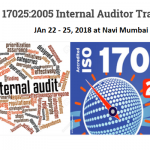ISO 14064 GHG Inventorization – An Overview
The standard ISO 14064 is an international standard that addresses the quantification and reporting of greenhouse gas emissions and the verification of this information. The development of ISO 14064, an addition to the ISO 14000 environmental management standard series, began in 2002. It will provide an overview of the structure of the standard and present key aspects of its design and application. ISO 14064 is a technical specification and is climate policy neutral.
ISO 14064 is a standard developed under processes of the International Standards Organization. A non-governmental organization located in Geneva, Switzerland, the International Organization for Standardization (ISO) coordinates efforts by groups of technical experts representing individual national standard institutes to develop consensus-based voluntary technical standards on variety of issues. ISO has issued over 16,000 standards including the well known ISO 9000 and ISO 14000 standard series on quality and environmental management, respectively. The objective of ISO standards is to facilitate international cooperation, especially business and trade, by facilitating communication on technical issues between industry, government, consumers, and other stakeholders and allowing consistency of products and services within and across national boundaries.
ISO 14064 is an offset protocol. It is an independent, voluntary GHG project accounting standard, and is policy neutral. The ISO 14064 standard consists of three parts. The first part (14064-1) specifies requirements for designing and developing organization or entity-level GHG inventories. The second part (14064-2) details requirements for quantifying, monitoring and reporting emission reductions and removal enhancements from GHG projects. The third part (14064-3) provides requirements and guidance for the conducting of GHG information validation and verification.
For example, ISO points out that additionality needs to be taken into account but does not require a specific tool or additionality test to be used. These would be defined by the GHG programme or regulation under which ISO 14064 is used.
STRUCTURE OF ISO 14064
ISO 14064 consists of three parts, each with a different technical focus. Part 1 of the standard is titled “Specification with guidance at the organization level for quantification and reporting of greenhouse gas emissions and removals.†This part of the standard addresses conducting greenhouse gas emission inventories of organizations such as corporations using a bottom up approach to data collection, consolidation and emissions quantification.
Part 2 of the standard addresses quantification and reporting of emission reductions from project activities.
Part 3 of the standard is titled “Specification with guidance for the validation and verification of greenhouse gas assertions.†This part of the standard establishes a process for verification of a greenhouse gas statement, including organization inventories, regardless of whether or not the inventory was developed under Part 1. This verification process is also applicable whether the verification is being conducted by an independent third party verifier or by an organization’s internal auditors.
KEY ASPECTS REGARDING ISO 14064 GHG INVENTORIES
ISO 14064, Part 1 includes eight major sections with over 21 subsections discussing GHG inventory issues for organizations. At the beginning, the standard establishes and defines general GHG inventory principles of relevance, completeness, consistency, accuracy, and transparency. These principles serve to assist with both interpretation of the standard as well as general guidance for addressing issues that fall beyond the practices established by the standard.
Within the primary text, the standard identifies three key aspects for developing a greenhouse gas inventory for organization. These aspects include setting inventory boundaries, quantifying GHGs, and reporting GHGs. Boundaries for a GHG inventory include both the organizational boundaries and the operational boundaries. Organizational boundaries refer to defining which facilities are recognized as part of organization conducting the inventory and should be included within this inventory. Two approaches to defining organizational boundaries are by control and according to equity share. Under the control approach, an organization looks at facilities where it has authority to implement either financial or operational policies, then accounts for all GHG emissions from facilities where it does have control. Under the equity share approach, the organization accounts for emissions from all facilities in which it has some equity interest (even a minority), but accounts for only a percentage of the total emissions equal to the share it has in the particular facility or sub-entity.
Operational boundaries refer to which operational activities at a facility are included in the inventory. Direct GHG emissions, or emissions that result from activities directly under an organizations control, such as combustion of fossil fuels to generate heat, are always included within the inventory. Indirect GHG emissions, or emissions that result from organization activities but are generated outside the boundaries of the organization’s direct control, may or may not be included. Indirect emissions from electricity generation are always included but other indirect emissions, such as those resulting from employee travel in non-organization owned vehicles (e.g. commercial airlines) are optionally included.
ISO 14064 Part 1 establishes a process for quantifying GHG emissions for the inventory. The first steps of this process are identification of specific emission sources within the operational boundaries as well as selection of an emissions quantification methodology applicable for the sources identified. The next steps are the collection of data required by the methodology for the source and the identification of established emission factors for the data collected. Finally, the data and the emission factors, applied consistent with the quantification methodology, are used to quantify emissions from individual emission sources. The emissions quantified for each source are then consolidated with the other sources within the operational boundaries, but ensuring that direct and indirect sources are kept separate.
With respect to GHG inventory reporting, ISO 14064 establishes that the report for each reporting period should identify the entity’s organizational boundaries, the GHG emissions from
individual operational categories, and the methodologies used to quantify those emissions. The report should include appropriate explanation regarding these inventory components, especially any exclusions from within the established boundaries or adjustments to the methodologies. The report should also identify what particular standards (including ISO 14064 for example) or programs the inventory was conducted consistent with and whether verification relative to these standards or programs was undertaken.
ISO 14064 exists as a guide for the private and public sector in developing GHG inventories for their organization as well as foundation for policy makers and program developers for initiatives to address the global environmental challenge of climate change.
If you would like to learn more, contact us at info@lakshy.com or visit www.lakshy.com or call our 24 hours customer care +91 9821780035 to get your organization ISO 14001:2004 certified.







